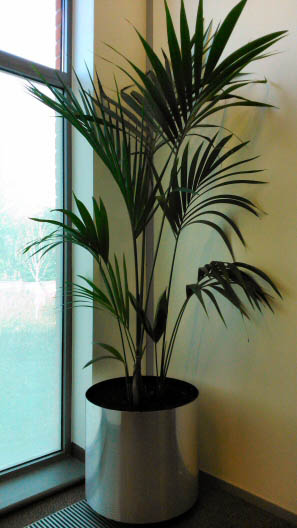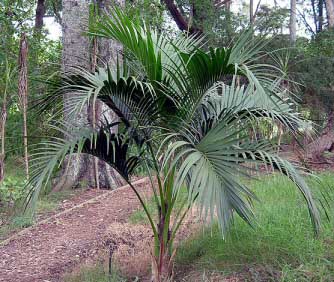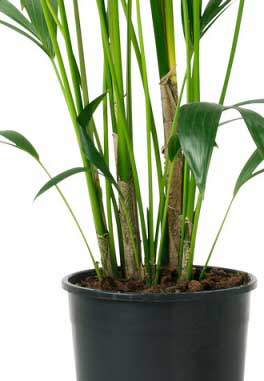





Howea is a genus of only two palms, Howea forsteriana (Kentia Palm) and Howea belmoreana (Sentry Palm) both of which can be grown as indoor plants.  Although some of the most expensive palms you can buy, they are both attractive and come with a natural cast-iron constitution and therefore are often well worth the investment.
Although some of the most expensive palms you can buy, they are both attractive and come with a natural cast-iron constitution and therefore are often well worth the investment.
In general, palms make fantastic house plants that give an air of the exotic and are a favorite large office plant used by interior decorators. They are consistently the best performing when it comes to removing pollution from the air, also transpire heavily making them brilliant natural humidifiers. In some peoples minds they come attached with a "difficult" rating, but this is largely unfounded, our care instructions below will provide you with everything you need to know. In addition to the instructions, remember these tips - never repot too frequently and never prune a growing stem or yank dead parts off (always cut instead of pulling) and then the only "difficult" aspect is actually going wrong with them.
We don't normally combine two different house plants into one profile, but the care requirements are identical and the plants are so similar looking people often get them confused anyway. This seems a good place to start as any so lets get the identification issue sorted out first.
Howea forsteriana - Kentia / Paradise Palm
Has flatter fronds with elegantly drooping leaflets and adapts much better to a life in a pot than H. belmoreana and consequently this Howea tends to be much more popular as a houseplant. (Picture above).
Howea belmoreana - Sentry / Curly Palm
H. belmoreana has curved leaves with erect leaflets and does not do as well in a pot as H. forsteriana because its roots prefer to have less restriction which a plant pot naturally does not provide.  For this reason H. belmoreana tends to more popular as an outdoor garden plant (in subtropical climes only of course!) therefore unless you can provide a deep pot it might be best to keep with the status quo and pick the Kentia over the Sentry if you have an indoor location already picked out. (Picture left).
For this reason H. belmoreana tends to more popular as an outdoor garden plant (in subtropical climes only of course!) therefore unless you can provide a deep pot it might be best to keep with the status quo and pick the Kentia over the Sentry if you have an indoor location already picked out. (Picture left).
Light
Low light is acceptable, deep shade and direct sunlight are not. Using that scale, the best balance between growth and health is a decent semi light spot.
Watering
Palms are thirsty plants and so you need to be watering frequently to ensure the soil remains moist during the parts of the year when they are in active growth. The only time you need to reduce water is in Winter, but even then the soil should still be a little moist rather than completely dry. Make sure your chosen pot has good drainage because trapped water will end up creating soggy conditions which both the Kentia Palm and Sentry Palm passionately dislike.
Humidity
If your chose a placement in a room that is heated or air conditioned you will need to make sure the level of humidity around the plant is medium to high. The easiest way to achieve this is through misting, but there are other methods you can use. There are two main reason for this, firstly to deter Red Spider Mite which is the number one Howea insect pest and secondly because the leaflets are long lived any brown tips that are caused by dry air will remain for a long time before new fronds grow.
Palms are thirsty plants and so you need to be watering frequently
Feeding
A weak feed every couple of months is all you need to be aiming for here. As usual, if the plant isn't growing, for example when it's cold or in a dark position, then you don't need to feed at all.
Temperature
Average warmth is needed for growth which means between 15°C - 25°C / 59 °F - 70°F. Ideally night time temperatures should be on the cooler side, but never lower than 10°C / 50°F at any time.
Repotting
Palms do not like root disturbance so frequent repotting can be damaging. Fortunately on the flip side it takes time for the roots to fill the pots anyway, so it only needs to be done once every couple of years at most (very young plants may need to be repotted once a year or so until they reach a mature size). The Sentry Palm (H. belmoreana) will need a deep pot, and both varieties should be firmed / packed into their new homes by compacting the fresh compost around the root ball.
Propagation
These palms are expensive because when you factor in their slow growth rate, propagation is also very difficult. Even though many of the ourhouseplants.com team are experienced we would rather just go and buy a new one rather than attempting to propagate either of the Howea Palms. In any case, the only way to really do this is through seed and a high temperature is needed for germination, but even then you could be waiting between 2 to 12 months before sprouting starts.
Speed of Growth
Growth is rather slow even if you provide good light conditions and water correctly. In fact you may only get a few new stems every year. So if you want to end up with a big plant, just cheat and pick the biggest you can afford at purchase time.
Height / Spread
Very few indoor plants will ever surpass 3 m (10 ft) in height.
Flowers
Beautiful flowering Palms are very rare and neither the Kentia Palm or the Sentry Palm can claim something different. Unremarkable blooms before quickly becoming seed pods do appear on occasion, but it's all about the foliage.
Anything else?
Avoid heavy use of leafshine products as too much can damage the leaves.  Where possible just use a damp cloth to remove accumulations of dust. Finally you must never "prune" a stem back, it won't encourage new growth and will instead kill it. Additionally to prevent accidental stem damage always remove dead growth with a pair of sharp scissors rather than trying to pull it away.
Where possible just use a damp cloth to remove accumulations of dust. Finally you must never "prune" a stem back, it won't encourage new growth and will instead kill it. Additionally to prevent accidental stem damage always remove dead growth with a pair of sharp scissors rather than trying to pull it away.
If you're having problems identifying if you have a Howea or not, for example if your plant is very young, cast your eyes down to the stems poking out of the soil. Sentry Palms and Kentia Palms are not multi stemmed so they will have obvious gaps between them. They should look similar to those in the photo on the right.
Copyright © www.100flowers.win Botanic Garden All Rights Reserved